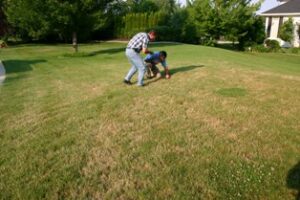Defending Your Turf

As you head into the busy season, it is an opportune time to develop a plan of attack for treating some of the most prevalent landscape turf insect pests. Matt Giese, Syngenta technical field manager for the Midwest, recently provided helpful insight on turf pests common to regions of the United States
“Across the Northern regions of the United States, the key pests are fairly similar,” said Giese. “It is primarily white grubs and billbugs impacting the cool-season turf in commercial and residential areas.”
According to Giese, a key point to keep in mind is that homeowners can often see pests in their landscapes and gardens, such as Japanese beetles or tomato hornworms, but they don’t generally see pests that typically lurk beneath the surface and cause damage.
“The most damaging turf pests reside in the soil or deep down in the turf canopy,” said Giese. “You don’t see them until the turf turns off color. For example, white grubs are challenging because it’s not the adults doing the damage, it is the larvae that feed on turf roots. So a preventive insecticide application is key for controlling the larvae before the turf shows signs of injury.”
According to Giese, it can be difficult to distinguish the advanced stages of turf damage caused by white grubs or billbugs from summer stress or drought stress. Giese advises lawn maintenance professionals to inspect the affected area and see if it can be pulled up or rolled back like a carpet. If the turf pulls up easily during a tug test, that is typically a sign of white grubs or billbugs.
“If you have white grubs or billbugs, it is typically a perennial problem, especially in high maintenance, irrigated turf,” said Giese. “From a preventive control standpoint, it is key to apply the insecticide prior to the insect inhabiting the area. Their life cycle is to overwinter as larvae (larvae and adults for billbugs), pupate into beetles, mate, and lay eggs. The larvae we are targeting hatch from eggs in July to August, so you want to water in the insecticide prior to that time.”
According to Giese, there are several treatment options for white grubs and billbugs. Applications of Acelepryn insecticide in April or May will provide season-long control of white grubs and billbugs. Neonicotinoids such as Merit insecticide and Meridian insecticide are also effective when applied preventively in June or early July. Meridian also has activity on later stages of larvae including first and second instar stages, Giese noted.
Preventive treatment is more cost effective, because one treatment of Acelepryn provides season-long control, whereas curative treatments may require more than one application, and thus additional product, additional visits and additional time spent on the job, he added.
According to Giese, in the Western United States, billbugs are more of a problem than white grubs. For billbugs, pitfall traps can be used to scout population levels or adult activity levels. This can be a Solo cup or similar container placed down in the soil. As billbugs move through the turf canopy, they fall into the cup and can’t get out. Preventive applications for billbugs are generally timed at peak adult activity, so monitoring a pitfall trap can be an effective way to properly time insecticide applications.
In the Southern regions of the United States, hunting billbugs in zoysiagrass have become more of an issue in recent years, said Giese. Hunting billbug damage can look like drought stress and it is tough to find the small, legless larvae. Proper diagnosis often requires analysis by a university or extension service.
“Billbugs are something we are keeping an eye on,” said Giese. “We’re not sure of the long-term ramifications, but we hadn’t seen them in warm-season turf until three or four years ago, or at least diagnosed them as the causal insect. So that is definitely something to watch.”
Florida doesn’t have issues with white grubs, but it does have chinch bugs. Some neonicotinoids, such as Meridian, are effective, as are some pyrethroids, such as Scimitar insecticide, he said.
Keeping notes or records of past treatments and scouting results are a good ways to identify properties with perennial insect problems and can assist with future planning and treatment options. Photographs of previous year damage can also be effective in persuading homeowners to renew these types of services.
Laws and regulations do change, and Giese recommends keeping up to date with PLANET, as well as state and local organizations, and local extension agents to stay current with the pesticide requirements and legislation in your area.
For more information, visit www.GreenCastOnline.com.
Important: Always read and follow label instructions before buying or using Syngenta products. The label contains important conditions of sale, including limitations of warranty and remedy. All products may not be registered in all states. Please check with your state or local Extension Service before buying or using Syngenta products. Scimitar GC is a Restricted Use Pesticide. Acelepryn, Meridian and Scimitar are registered trademarks of a Syngenta Group Company. Merit is a registered trademark of BayerCropScience Ltd.




